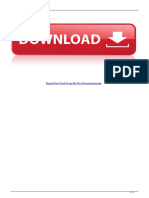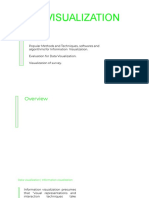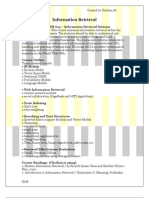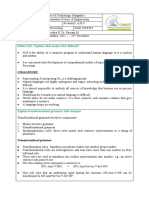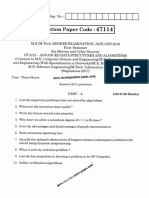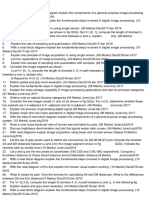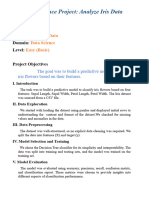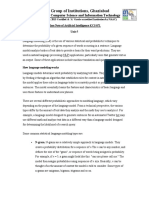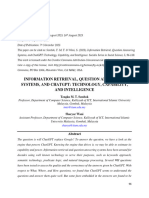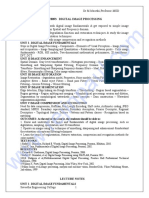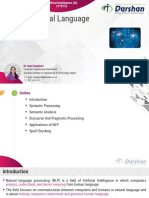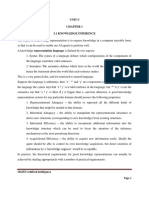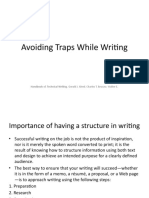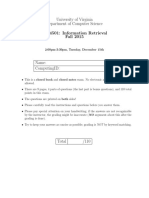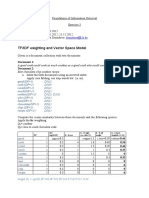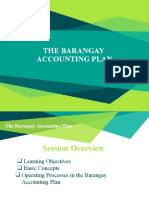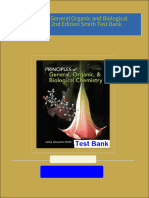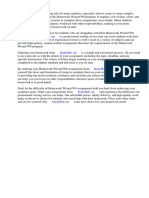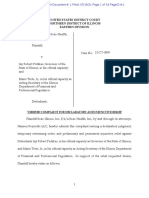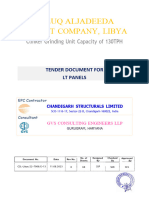0 ratings0% found this document useful (0 votes)
209 viewsInformation Retrieval Systems (A70533)
Information Retrieval Systems (A70533)
Uploaded by
Bhavy SinghThis document provides the course planner for an Information Retrieval Systems elective course offered at Bharat Institute of Engineering and Technology. The course aims to present concepts in information search and retrieval using models like vector space, Boolean, and query expansion. It discusses implementation and evaluation of retrieval algorithms and facilitates designing search tools for e-commerce websites. The course objectives are demonstrated through assignments, projects, lectures and tutorials assessing students' understanding of retrieval systems and their ability to implement algorithms and design inverted indexes.
Copyright:
© All Rights Reserved
Available Formats
Download as PDF, TXT or read online from Scribd
Information Retrieval Systems (A70533)
Information Retrieval Systems (A70533)
Uploaded by
Bhavy Singh0 ratings0% found this document useful (0 votes)
209 views11 pagesThis document provides the course planner for an Information Retrieval Systems elective course offered at Bharat Institute of Engineering and Technology. The course aims to present concepts in information search and retrieval using models like vector space, Boolean, and query expansion. It discusses implementation and evaluation of retrieval algorithms and facilitates designing search tools for e-commerce websites. The course objectives are demonstrated through assignments, projects, lectures and tutorials assessing students' understanding of retrieval systems and their ability to implement algorithms and design inverted indexes.
Original Description:
notification parts of information retrieval and search engine.
Original Title
Information Retrieval Systems (a70533)
Copyright
© © All Rights Reserved
Available Formats
PDF, TXT or read online from Scribd
Share this document
Did you find this document useful?
Is this content inappropriate?
This document provides the course planner for an Information Retrieval Systems elective course offered at Bharat Institute of Engineering and Technology. The course aims to present concepts in information search and retrieval using models like vector space, Boolean, and query expansion. It discusses implementation and evaluation of retrieval algorithms and facilitates designing search tools for e-commerce websites. The course objectives are demonstrated through assignments, projects, lectures and tutorials assessing students' understanding of retrieval systems and their ability to implement algorithms and design inverted indexes.
Copyright:
© All Rights Reserved
Available Formats
Download as PDF, TXT or read online from Scribd
Download as pdf or txt
0 ratings0% found this document useful (0 votes)
209 views11 pagesInformation Retrieval Systems (A70533)
Information Retrieval Systems (A70533)
Uploaded by
Bhavy SinghThis document provides the course planner for an Information Retrieval Systems elective course offered at Bharat Institute of Engineering and Technology. The course aims to present concepts in information search and retrieval using models like vector space, Boolean, and query expansion. It discusses implementation and evaluation of retrieval algorithms and facilitates designing search tools for e-commerce websites. The course objectives are demonstrated through assignments, projects, lectures and tutorials assessing students' understanding of retrieval systems and their ability to implement algorithms and design inverted indexes.
Copyright:
© All Rights Reserved
Available Formats
Download as PDF, TXT or read online from Scribd
Download as pdf or txt
You are on page 1of 11
INFORMATION
RETRIEVAL SYSTEMS
Subject Code: A70533
Regulations: R15 – JNTUH
Class: IV Year B.Tech CSE I Semester
Department of Computer Science and Engineering
BHARAT INSTITUTE OF ENGINEERING AND TECHNOLOGY
Ibrahimpatnam - 501 510, Hyderabad
INFORMATION RETRIEVAL SYSTEMS (A70533)
(Elective – 2)
COURSE PLANNER
I. COURSE OVERVIEW:
The main objective of this course is to present the scientific support in the field
of information search and retrieval. This course explores the fundamental
relationship between information retrieval, hypermedia architectures, and
semantic models, thus deploying and testing several important retrieval models
such as vector space, Boolean and query expansion. It discusses
implementation and evaluation issues of new algorithms like clustering, pattern
searching, and stemming with advanced data/file structures, indirectly
facilitating a platform to implement comprehensive catalogue of information
search tools while designing an e-commerce web site
II PRE-REQUISITES
1. Students must have the minimal concept of Data Base Management Systems
2. They must also have the concept of different types of algorithms used for searching data
3. They must also have the minimal knowledge of Natural language such as thesaurus,
synonyms etc. to understand the concept of retrieving the textual information because
text is the main data type used in Information Retrieval Systems
III. COURSE OBJECTIVES:
Demonstrate genesis and diversity of information retrieval situations for text and
1
hyper media.
Describe hands-on experience store, and retrieve information from www using
2
semantic approaches.
Demonstrate the usage of different data/file structures in building computational
3
search engines.
Analyze the performance of information retrieval using advanced
4 techniques such as classification, clustering, and filtering over
multimedia.
Analyze ranked retrieval of a very large number of documents with hyperlinks
5
between them.
Demonstrate Information visualization technologies like Cognition and perception in
6
the Internet or Web search engine.
IV. COURSE OUTCOMES:
S.No Description Blooms level of taxonomy
Describe the objectives of information retrieval
1 Understanding
systems.
Describe models like vector-space, probabilistic
2 and language models to iidentify the similarity of Understanding
query and document.
Implement clustering algorithms like hierarchical
3 Create
agglomerative clustering and k-means algorithm.
Understand relevance feedback in vector space
4 Understanding
model and probabilistic model.
Illustrate how N-grams are used for detection and
5 Understanding, Knowledge
correction of spelling errors.
6 Understand the method of Regression analysis to Understanding
estimate the probability of relevance.
Understand the method to construct thesauri
7 Understanding
automatically and Manually.
Understand natural language systems to build
8 Understanding, Knowledge
semantic networks for text.
Illustrate algorithms used for natural language
9 Understanding
processing.
Understand the measures to evaluate the
10 Understanding
performance of cross language information
Understand query, document and phrase
11 translation. Understanding, Knowledge
12 Design the method to build inverted index. Create
VII V. HOW PROGRAM OUTCOMES ARE
. ASSESSED:
Program Leve Proficiency
assessed by
Outcomes l
PO1 Engineering knowledge: the knowledge mathematics Assignments
Apply of , 3
science, engineering fundamentals, and an engineering ,
specialization Tutorials
to the solution of complex engineering
problems.
PO2 Problem analysis: Identify, formulate, review research
literature, and 3 Assignments
analyze engineerin problems reachin substantiate
complex g g d
conclusions using first principles of mathematics, natural
sciences, and
engineering sciences.
PO3 Design/development of solutions: Design solutions for
complex
engineering problems and design system components or 2 Mini
processes that Projects
meet the specified needs with appropriate consideration for
the public
health and safety, and the cultural, societal, and
environmental
considerations
.
PO4 Conduct investigations of complex problems: Use
research-based 2 Projects
knowledge and research includin design of
methods g experiments,
analysis and interpretation of data, and synthesis of the
information to
provide valid conclusions.
PO5 Modern tool usage: Create, select, and apply appropriate
techniques, 2 Mini
resources, and modern engineering and IT tools including Projects
prediction
and modeling to complex engineering activities with an
understanding
of the
limitations.
PO6 The engineer and society: Apply reasoning informed by
the 2 Assignments
contextual knowledge to societal, health, safety, legal
assess and
cultural issues and the consequent responsibilities relevant
to the
professional engineering
practice.
PO7 Environment and sustainability: Understand the impact
of the -- --
professional engineering in societal and environmenta
solutions l
contexts, and demonstrate the knowledge of, and need for
sustainable
development.
PO8 Ethics: Apply ethical principles and commit to -- --
professional ethics and
responsibilities and norms of the
engineering practice.
PO9 Individual and team work: Function effectively as an
individual, and -- --
as a member or leader in diverse teams, and in
multidisciplinary
settings.
PO1 Communication: Communicate effectively on complex
0 engineering
activities with the engineering community and with society 2 Assignments
at large,
such as, being able to comprehend and write effective
reports and
design documentation, make effective presentations, and
give and
receive clear instructions.
PO11 Project management and finance: Demonstrate
knowledge and -- --
understanding the and management principles
of engineerin and
g
apply these to one’s own work, as a member and leader in
VI. HOW PROGRAM SPECIFIC OUTCOMES ARE ASSESSED:
Program Specific Outcomes Level Proficiency
assessed by
PSO1 Professional Skills: The ability to research, understand
and implement computer programs in the areas related Lectures,
3 Assignments
to algorithms, system software, multimedia, web
design, big data analytics, and
networking for efficient analysis and design of
computer-based systems of varying
complexity.
PSO2 Problem-Solving Skills: The ability to apply standard
practices and strategies in software 3 Mini
Projects
project development
usingopen-ended programming
environments to deliver a quality product for business
success.
PSO3 Successful Career and Entrepreneurship: The ability
to employ modern computer languages, environments, 2 Guest
and platforms in creating innovative career paths, to be Lectures
an entrepreneur, and a zest for higher
studies.
N – None S - Supportive H - Highly Related
VII SYLLABUS:
UNIT – I:
Introduction: Retrieval strategies: vector space model, Probabilistic retrieval strategies:
Simple term weights, Non binary independence model, Language models.
UNIT – II:
Retrieval Utilities: Relevance feedback, clustering, N-grams, Regression analysis, Thesauri.
UNIT – III:
Retrieval utilities: Semantic networks, parsing
Cross –Language: Information Retrieval: Introduction, Crossing the Language barrier.
UNIT – IV:
Efficiency: Inverted Index, Query processing, Signature files, Duplicate document detection.
UNIT – V:
Integrating structured data and text. A historical progression, Information retrieval as
relational application, Semi Structured search using a relational schema.
Distributed Information Retrieval: A theoretical Model of Distributed retrieval, web search
SUGGESTED BOOKS
Text books:
1. David A. Grossman, OphirFrieder, Information Retrieval – Algorithms and Heuristics,
Springer, 2nd Edition( Distributed by Universal Press), 2004
Reference books:
1. Gerald J Kowalski, Mark T Maybury Information Storage and Retrieval Systems: Theory
and Implementation, Springer, 2004.
2. SoumenChakrabarti, Mining the Web : Discovering Knowledge from Hypertext Data,
Morgan – Kaufmann Publishers, 2002.
3. Christopher D Manning, PrabhakarRaghavan, HinrichSchutze, An Introduction to
Information Retrieval By Cambridge University Press, England, 2009.
VIII. COURSE PLAN:
Course
Lectur Wee Reference
Topic Learning
e k s
Outcomes
UNIT -I
1. Introduction T1, R3
Retrieval strategies: Introduction Understandin
g information
2.
1 retrieval
strategies
3. vector space model With examples
4. vector space model
Probabilistic retrieval strategies:
5.
Introduction
6. Simple term weights
7. 2 Non binary independence model
Non binary independence model,
8.
Language models
Mock Test #1
UNIT-II
9. Retrieval Utilities overview
10. Introduction
11. Retrieval Utilities overview T1, R3
Relevance feedback Knowledge
gathering
3
about Retreival
12.
Utilities and
relevance
feedback
Tutorial / Bridge Class # 1
13. Relevance feedback
14. Relevance feedback
15. 4 clustering
16. Clustering cont’d
Tutorial / Bridge Class # 2
17. N-grams
18. Regression analysis
19. 5 Regression analysis
20. Thesauri.
Tutorial / Bridge Class # 3
UNIT- III
21. Retrieval utilities T1, R3
Retrieval utilities cont’d Applying and
22. examine case
6
studies
23. Case study #1
24. Case study #2
Tutorial / Bridge Class # 4
25. Semantic networks
7
26. Semantic networks cont’d
Case study #1
27.
29. Case study #2
Tutorial / Bridge Class # 5
30. Parsing
31. Parsing cont’d
32. 8 Case study #1
33. Case study #2
Tutorial / Bridge Class # 6
MID-TERM #1 EXAMINATIONS (WEEK-9)
X. MAPPING COURSE OBJECTIVES LEADING TO THE
ACHIEVEMENT OF PROGRAM OUTCOMES AND PROGRAM
SPECIFIC OUTCOMES:
Program Specific
Program Outcomes
CO Outcomes
PO1 PO2 PO3 PO4 PO5 PO6 PO7 PO8 PO9 PO10 PO11 PO12 PSO1 PSO2 PSO3
1 3 -- -- 3 -- -- -- -- -- 2 -- -- 2 -- --
2 -- 3 -- -- -- -- -- -- -- -- -- -- -- 3 --
3 -- 3 3 -- -- -- -- -- -- -- -- -- -- 2 --
4 2 -- -- -- -- -- -- -- -- 3 -- -- 3 -- 2
5 -- -- -- 3 -- -- -- -- -- -- -- -- -- 3 --
6 3 -- -- -- -- 2 -- -- -- -- -- 3 -- 2 --
7 -- -- 3 -- -- -- -- -- -- -- -- -- -- 3 --
8 -- -- -- 3 -- -- -- -- -- 3 -- -- -- 2 --
9 3 -- -- -- -- -- -- -- -- 2 -- 3 2 -- --
10 -- 3 2 -- -- -- -- -- -- -- -- -- -- 3 --
11 3 -- -- -- -- -- -- -- -- 3 -- -- 3 -- --
12 -- -- 3 -- -- -- -- -- -- -- -- -- -- 3 --
AVG 1.2 0.8 0.9 0.8 0 0.2 0 0 0 1.08 0 0.5 0.833 1.75 0.167
X QUESTION BANK
Blooms Course
Taxonomy
S No Question Level Outcome
UNIT – I
Part - A (Short Answer Questions)
1 Define information retrieval system? Knowledge 1
Differentiate DBMS with information retrieval
2 system? Understand 1
3 Differentiate browsing vs. Searching? Knowledge 1
Explain your answer with relevant example Can
4 information retrieval Knowledge 1
system be related to a database management system?
5 Define briefly terms Knowledge 1
1. Precision
2. Recall
6 List 5 challenges of searching for information o the web? Knowledge 1
7 List 3 difference between data retrieval and information Knowledge 1
retrieval?
Part - B (Long Answer Questions)
Explain the differences between Information Retrieval
1 Systems Apply 1
and DBMS?
2 Explain similarity coefficient and determine the ranking of Knowledge 2
following documents
Q:gold silver truck
D1:shipment of gold damaged in a fire
D2:delivery of silver arrived in a silver truck
D3:shipment of gold arrived in a truck
Explain the concept of simple term weights for the above
3 query Understand 2
and documents?
4 Explain inverse document frequency? Evaluate 1
5 Explain about the objectives of IRS? Understand 1
UNIT – II
Part - A (Short Answer Questions)
1 Explain the purpose of retrieval utilities? Knowledge 3
2 Explain the concept of clustering as a retrieval utility? Understand 3
Explain how Relevance feedback is used to improve the
3 results Knowledge 4
of retrieval strategy?
4 Explain N-gram data structure? Knowledge 5
5 Describe regression analysis? Knowledge 6
Part - B (Long Answer Questions)
1 Explain about relevance feedback in vector space model? Understand 3
2 Explain about relevance feedback in probabilistic model? Understand 3
3 Discuss the use of manually generated thesaurus? Knowledge 5
4 Explain the concept of thesauri by constructing term-term Knowledge 3
similarity matrix?
5 Explain the approach of regression analysis to estimate the Knowledge 3
probability of relevance?
Unit III / Part - A (Short Answer Questions)
Discuss R-distance for calculating distance between query
1 and Understand 8
document?
2 Describe how ranking is based on constrained spreading Knowledge 8
activation?
Explain how NLP is used to reduce ambiguity in
3 language? Knowledge 9
4 Define cross language information retrieval? Apply 10
5 Define query translation? Understand 11
Part - B (Long Answer Questions)
1 Explain the concept of semantic networks for automatic Create 6
relevance ranking?
2 Explain why parsing is an essential feature of information Understand 8
retrieval system?
3 Explain three different types of translations? Apply 9
4 Discuss unbalanced and structured queries approaches for Understand 10
choosing translations?
5 Explain about syntactic parsing? Understand 8
UNIT - IV
Part - A (Short Answer Questions)
1 Explain index pruning? Knowledge 12
2 Explain posting list? Understand 12
3 Define document file? Understand 12
4 Describe index? Understand 13
5 Explain about I-Match? Understand 13
Part - B (Long Answer Questions)
Explain methods to reorder documents prior to
1 indexing? Understand 13
2 Discuss methods to compress an inverted index? Knowledge 13
3 Define efficiency? Explain about inverted index? Knowledge 13
4 Explain about throughput-optimized compression? Create 12
5 Explain various top-down and bottom-up algorithms? Create 12
9 Describe the method for finding similar duplicates? Understand 12
Explain how signature files are used to detect
10 duplicates? Understand 12
UNIT - V
Part - A (Short Answer Questions)
1 Define Data Integrity? Knowledge 14
2 Defin performance? Understand 14
Defin
3 e Portability? Understand 14
4 Explain are the extensions to SQL? Understand 14
5 List different types of User-defined Operators? Understand 14
Part - B (Long Answer Questions)
1 Explain about historical progression? Create 14
2 Discuss briefly about user-defined operators? Understand 14
3 Explain Non-first normal form approaches? Understand 14
Discuss about information retrieval as a relational
4 application? Understand 14
5 Explain about Boolean queries? Apply 14
XII OBJECTIVE QUESTIONS
UNIT-I
1.Which function is primarily used to compensate for errors in spelling of words? [ ]
A) Fuzzy B) Indexing C) Ranking D) Zoning
2.The _________ system that acts as a user frontend to the Retrieval are search system
allows the user to browse an item in the order of the paragraphs [ ]
A) OCR B) INQUERY C) DCARS D) NISO
3. The transformation from the received item to the searchable data structure is called[ ]
A) Ranking B) Indexing C) Term Masking D) None
4. The process of creating term linkages at index creation time is called_______ [ ]
A) Post-coordination B) Indexing C) Pre-coordination D) None
5. Concept indexing determines a ________set of concepts based upon a test set of terms and
uses them as a basis for indexing all items [ ]
A) Canonical B) Searching C) Associated D) Relationship
UNIT-II
1. Precision is directly affected by retrieval of non-relevant items and drops to a number
close to ____
2. The rank-frequency law of Ziph is___________
3. The format for proximity is: TERM1 within “m” “units” of TERM2 m___________
4. The _________process is a pattern recognition process that segments the scanned in
image into sub-regions
5. Under Boolean systems, the status display is a count of the number of items found by
the query is____________
UNIT-III
1. An___________________ is a system that is capable of storage, retrieval, and
maintenance of information.
2. The success of IRS can be measured by __________
3. The measures associated with IRS are __________ and ______________(precision
and recall)
4. AFB stands for _______________________(Automatic File Build)
5. The masking is done for single character in __________________
UNIT-IV
1. Words shares the same written form but a different meaning is known as
______________
2. Process of creating term linkages at index creation time is called ________________
3. The weighted systems are mostly known as ________________________
4. SMIL stands for ______________(Synchronized Multimedia Integrated Language)
5. The process of converting the received item into searchable data structure is known as
--------------------
UNIT-V
1. The structure that deals with layout of document context is __________________
2. QBIC is abbreviated as __________________
3. OPAC is abbreviated as _____________________
4. Set of digital objects is treated as __________________
5. The system used by DIALOG is ________________________
XII. RELEVANT SYLLABUS FOR GATE: Not applicable
RELEVANT SYLLABUS FOR IES: Not applicable
XIII WEBSITES
1. Information Storage and Retrieval Systems: Theory and Implementation By Kowalski
(UNIT I to UNIT VI)
2. Modern Information Retrieval by Ricardo Beeza-Yates ( UNIT VII and UNIT VIII)
XIV EXPERT DETAILS
1. Dr.S.ViswanadhaRaju,Professor of CSE JNTUHCE, JNT University Hyderabad
2. Dr. A GovardhanProfessor Computer Science & Engineering at School of
InformationTechnology, Jawaharlal Nehru Technological University Hyderabad
(JNTUH), India
3. Dr. B Padmaja RaniProfessor & Head, Computer Science & Engineering JNTUH
College of Engineering Hyderabad (Autonomous)
XV JOURNALS
1. Information Storage and Retrieval Systems: Theory and Implementation By Kowalski
(UNIT I to UNIT VI)
2. Modern Information Retrieval by Ricardo Beeza-Yates ( UNIT VII and UNIT VIII)
3. International Journal of Multimedia Information Retrieval (IJMIR)
4. International Journal of Information Retrieval Research (IJIRR
XVI .LIST OF TOPICS FOR STUDENT SEMINARS
1. Hypertext data structures and linkages
2. Stemming algorithms
3. Manual clustering
4. Information visualization
5. Measures of Information evaluation
6. Multimedia retrieval systems
XVII .CASE STUDIES/SMALL PROJECTS
Presentation on image query processing i.e. about QBIC
Presentation on one of the case studies of Information Retrieval System
You might also like
- Bangla Hasir Natok Script PDF Free DownloadinstmankDocument4 pagesBangla Hasir Natok Script PDF Free DownloadinstmankRupak SahaNo ratings yet
- Agarwal Cargo Packers and MoversDocument5 pagesAgarwal Cargo Packers and MoversSDawNo ratings yet
- Employer BrandingDocument5 pagesEmployer BrandingiResearchers OnlineNo ratings yet
- (A) What Is Traditional Model of NLP?: Unit - 1Document18 pages(A) What Is Traditional Model of NLP?: Unit - 1Sonu KumarNo ratings yet
- Week 1 QuizDocument6 pagesWeek 1 QuizBhavy SinghNo ratings yet
- Solutions To NLP I Mid Set ADocument8 pagesSolutions To NLP I Mid Set Ajyothibellaryv100% (1)
- Data Visualization PDFDocument90 pagesData Visualization PDFKinshuk KujurNo ratings yet
- Information Retrieval Systems U6Document13 pagesInformation Retrieval Systems U6Durga BhavaniNo ratings yet
- Cs8080informationretrievaltechniquesunit Ipptpdfversion 220423092105Document240 pagesCs8080informationretrievaltechniquesunit Ipptpdfversion 220423092105senthilNo ratings yet
- CASE STUDY - Speech RecognitionDocument25 pagesCASE STUDY - Speech Recognitionnaina nautiyalNo ratings yet
- CHP - 1 - Fundamentals of Digital Image MinDocument15 pagesCHP - 1 - Fundamentals of Digital Image MinAbhijay Singh JainNo ratings yet
- Department of Information TechnoloDocument116 pagesDepartment of Information Technolodee pNo ratings yet
- Cp7004 Image Processing and Analysis 1Document8 pagesCp7004 Image Processing and Analysis 1Vishnu KumarNo ratings yet
- Be Computer Engineering Semester 7 2023 May Dloc III Natural Language Processing Rev 2019 C SchemeDocument2 pagesBe Computer Engineering Semester 7 2023 May Dloc III Natural Language Processing Rev 2019 C Scheme19OM DHEMBRE0% (1)
- Unit-I Introduction To Image ProcessingDocument23 pagesUnit-I Introduction To Image ProcessingSiva KumarNo ratings yet
- Completed UNIT-III 20.9.17Document61 pagesCompleted UNIT-III 20.9.17Dr.A.R.KavithaNo ratings yet
- Com713 Advanced Data Structures and AlgorithmsDocument13 pagesCom713 Advanced Data Structures and AlgorithmsThilinaAbhayarathneNo ratings yet
- Information Retrieval 1Document12 pagesInformation Retrieval 1Chethan.M100% (2)
- Completed Unit II 17.7.17Document113 pagesCompleted Unit II 17.7.17Dr.A.R.KavithaNo ratings yet
- Part I IR VTU M Tech SSEDocument72 pagesPart I IR VTU M Tech SSENatarajanSNo ratings yet
- NLP Iat QBDocument10 pagesNLP Iat QBABIRAMI SREERENGANATHANNo ratings yet
- Unit V Intelligence and Applications: Morphological Analysis/Lexical AnalysisDocument30 pagesUnit V Intelligence and Applications: Morphological Analysis/Lexical AnalysisDhoni viratNo ratings yet
- Natural Language ProcessingDocument21 pagesNatural Language ProcessingZain Tech TipsNo ratings yet
- Information Retrieval SytemDocument18 pagesInformation Retrieval SytemS. Kuku DozoNo ratings yet
- C Programming and Data StructuresDocument5 pagesC Programming and Data StructuresMENAGANo ratings yet
- Cp5151 Advanced Data Structures and AlgorithimsDocument3 pagesCp5151 Advanced Data Structures and AlgorithimsPragaDarshNo ratings yet
- Lecture 1: Introduction To NLP: Understand Concepts ApplicationsDocument32 pagesLecture 1: Introduction To NLP: Understand Concepts ApplicationsManaal AzfarNo ratings yet
- Week 6: Introduction To Natural Language ProcessingDocument18 pagesWeek 6: Introduction To Natural Language ProcessingDimpu ShahNo ratings yet
- 17EC72 DIP Question BankDocument12 pages17EC72 DIP Question Bankjay bNo ratings yet
- IR UNIT I - NotesDocument23 pagesIR UNIT I - NotesAngelNo ratings yet
- NLP: Background and Overview: Introduction To Natural Language Processing (CSE5321)Document30 pagesNLP: Background and Overview: Introduction To Natural Language Processing (CSE5321)Naty Dasilva Jr.No ratings yet
- Semantic Information RetrievalDocument168 pagesSemantic Information RetrievalHabHabNo ratings yet
- Completed Final UNIT-V 9.10.17Document74 pagesCompleted Final UNIT-V 9.10.17Dr.A.R.Kavitha100% (1)
- Natural Language Processing: Dr. Tulasi Prasad Sariki SCOPE, VIT ChennaiDocument29 pagesNatural Language Processing: Dr. Tulasi Prasad Sariki SCOPE, VIT Chennainaruto sasukeNo ratings yet
- Module-5:: Network AnalysisDocument22 pagesModule-5:: Network AnalysisKv BdrNo ratings yet
- Semantic Web IntroductionDocument35 pagesSemantic Web IntroductionkhongminhphongNo ratings yet
- 10 Natural Language ProcessingDocument27 pages10 Natural Language Processingrishad93No ratings yet
- Unit IDocument30 pagesUnit IAnonymous rcmeSfj5No ratings yet
- Cs8080 Unit3 Text Classification and ClusteringDocument171 pagesCs8080 Unit3 Text Classification and ClusteringGnanasekaranNo ratings yet
- Natural Language ProcessingDocument20 pagesNatural Language ProcessingMian UsmanNo ratings yet
- CS8080 - IRT - Question Bank - R 2017 - GCTDocument10 pagesCS8080 - IRT - Question Bank - R 2017 - GCT20CS001 Abinaya S CSENo ratings yet
- An Ontology-Based NLP Approach To Semantic Annotation of Annual ReportDocument4 pagesAn Ontology-Based NLP Approach To Semantic Annotation of Annual ReportRajesh KumarNo ratings yet
- Data Science ProjectDocument3 pagesData Science Projectchandramoulibogala43No ratings yet
- Unit 5 - NotesDocument11 pagesUnit 5 - NotesBhavna SharmaNo ratings yet
- Ma5160 Applied Probability and Statistics 1 PDFDocument4 pagesMa5160 Applied Probability and Statistics 1 PDFPrabhakar Prabhaa50% (2)
- Information Retrieval, Question Answering Systems, and Chatgpt: Technology, Capability, and IntelligenceDocument15 pagesInformation Retrieval, Question Answering Systems, and Chatgpt: Technology, Capability, and IntelligenceGlobal Research and Development ServicesNo ratings yet
- Information Retrieval - Question BankDocument3 pagesInformation Retrieval - Question BankPapithaNo ratings yet
- CS8080 Information Retrieval Techniques Reg 2017 Question BankDocument6 pagesCS8080 Information Retrieval Techniques Reg 2017 Question BankProject 21-22No ratings yet
- Unit 1 2 3 4 5 NLP Notes MergedDocument105 pagesUnit 1 2 3 4 5 NLP Notes Mergednatih73213No ratings yet
- Table of ContentDocument13 pagesTable of Contentrekha_rckstarNo ratings yet
- Cs8080 Ir Unit2 I Modeling and Retrieval EvaluationDocument42 pagesCs8080 Ir Unit2 I Modeling and Retrieval EvaluationGnanasekaranNo ratings yet
- Data Centric Artificial Intelligence: A Beginner's GuideDocument137 pagesData Centric Artificial Intelligence: A Beginner's Guiderolorot958No ratings yet
- CB3491 QBankDocument27 pagesCB3491 QBankjesusjeeva1995No ratings yet
- Machine Learning (15CS73) Question Bank: 6. Consider The Following Set of Training ExamplesDocument2 pagesMachine Learning (15CS73) Question Bank: 6. Consider The Following Set of Training Examplesmohammed talibNo ratings yet
- CS6659 UNIT 5 NotesDocument25 pagesCS6659 UNIT 5 NotesprofBalamurugan89% (9)
- CSE4022 Natural-Language-Processing ETH 1 AC41Document6 pagesCSE4022 Natural-Language-Processing ETH 1 AC41Arkadeepta RoyNo ratings yet
- Ec8093 Dip - Question Bank With AnswersDocument189 pagesEc8093 Dip - Question Bank With AnswersSanthosh PaNo ratings yet
- CSE Image ProcessingDocument15 pagesCSE Image ProcessingGowtham Ambavaram0% (1)
- Unit-8: Natural Language: ProcessingDocument16 pagesUnit-8: Natural Language: Processingdemo dataNo ratings yet
- Speech Recognition ArchitectureDocument13 pagesSpeech Recognition ArchitectureDhrumil DasNo ratings yet
- CS6659 AI UNIT 3 NotesDocument30 pagesCS6659 AI UNIT 3 NotesprofBalamurugan50% (4)
- Python Data Analysis: Transforming Raw Data into Actionable Intelligence with Python's Data Analysis CapabilitiesFrom EverandPython Data Analysis: Transforming Raw Data into Actionable Intelligence with Python's Data Analysis CapabilitiesNo ratings yet
- How to Design Optimization Algorithms by Applying Natural Behavioral PatternsFrom EverandHow to Design Optimization Algorithms by Applying Natural Behavioral PatternsNo ratings yet
- Session-2 CharacteristicsDocument10 pagesSession-2 CharacteristicsBhavy SinghNo ratings yet
- Avoiding Traps While Writing: Handbook Of. Technical Writing. Gerald J. Alred. Charles T. Brusaw. Walter EDocument19 pagesAvoiding Traps While Writing: Handbook Of. Technical Writing. Gerald J. Alred. Charles T. Brusaw. Walter EBhavy SinghNo ratings yet
- Session-1 What Is Technical WritingDocument9 pagesSession-1 What Is Technical WritingBhavy SinghNo ratings yet
- CNS Mid ExamDocument1 pageCNS Mid ExamBhavy SinghNo ratings yet
- Session-4 Formal Vs Informal EnglishDocument17 pagesSession-4 Formal Vs Informal EnglishBhavy SinghNo ratings yet
- IR - Set 1Document5 pagesIR - Set 1Bhavy SinghNo ratings yet
- University of Virginia Department of Computer Science CS 4501: Information Retrieval Fall 2015Document10 pagesUniversity of Virginia Department of Computer Science CS 4501: Information Retrieval Fall 2015Bhavy SinghNo ratings yet
- Good IrmodelingDocument263 pagesGood IrmodelingBhavy SinghNo ratings yet
- Excercise3 Solution PDFDocument2 pagesExcercise3 Solution PDFBhavy SinghNo ratings yet
- ICP FEM4X60000b2 Fan Coil Installation InstructionsDocument17 pagesICP FEM4X60000b2 Fan Coil Installation Instructionssurya325kiranNo ratings yet
- Treatment Strategy For Frozen ShoulderDocument9 pagesTreatment Strategy For Frozen ShoulderDiah Rindayani HasbiNo ratings yet
- Advanced Excel NotesDocument156 pagesAdvanced Excel NotesErrY FlorenciaNo ratings yet
- U34P2C ManualDocument32 pagesU34P2C ManualgondanirenNo ratings yet
- Release Notes For Cisco Anyconnect VPN ClientDocument54 pagesRelease Notes For Cisco Anyconnect VPN ClientRyan BelicovNo ratings yet
- 2022 S C M R 2123Document6 pages2022 S C M R 2123Urooj LashariNo ratings yet
- 03-Slides - Barangay Accounting PlanDocument14 pages03-Slides - Barangay Accounting PlanMary Jane ManayamNo ratings yet
- Huawei eLTE Broadband Trunking Products PDFDocument27 pagesHuawei eLTE Broadband Trunking Products PDFJamal ZafarNo ratings yet
- Download full Principles of General Organic and Biological Chemistry 2nd Edition Smith Test Bank all chaptersDocument48 pagesDownload full Principles of General Organic and Biological Chemistry 2nd Edition Smith Test Bank all chapterslamevwahbi100% (5)
- Determination of Average Equalized) Cost ofDocument19 pagesDetermination of Average Equalized) Cost ofsamservNo ratings yet
- Org B Asgmt No. 2 (CHP 5) More Than A PaycheckDocument1 pageOrg B Asgmt No. 2 (CHP 5) More Than A PaycheckAnnaM0% (1)
- 1248 - 5 Analouge Electrical Measuring Instrument - Spl. Req. FDocument8 pages1248 - 5 Analouge Electrical Measuring Instrument - Spl. Req. Frpaliwal1967No ratings yet
- VM - PT Brochure - June 2021Document4 pagesVM - PT Brochure - June 2021Suresh MeesalaNo ratings yet
- Lime Storage and HandlingDocument3 pagesLime Storage and HandlingimmanjNo ratings yet
- Building Your Company's VisionDocument14 pagesBuilding Your Company's VisionVikasdeep SharmaNo ratings yet
- Homework Wizard w8Document4 pagesHomework Wizard w8ernq71xc100% (1)
- Cannabis LawsuitDocument34 pagesCannabis LawsuitCrains Chicago BusinessNo ratings yet
- (HTTPS://WWW - Autogenius.info/) : VW Golf mk4 (1997 - 2003) - Fuse BoxDocument4 pages(HTTPS://WWW - Autogenius.info/) : VW Golf mk4 (1997 - 2003) - Fuse Boxcjfoliveira100% (1)
- Legal Ethics Digest Requirement For FinalsDocument41 pagesLegal Ethics Digest Requirement For FinalsKaren PearlNo ratings yet
- Qut Blueshift Business Case Competition 2017 WorkbookDocument18 pagesQut Blueshift Business Case Competition 2017 WorkbookK59 Tran Duc TriNo ratings yet
- LT Panel Tender - LibyaDocument38 pagesLT Panel Tender - LibyaseemsanrajataccNo ratings yet
- Medical Supplies QuotationDocument8 pagesMedical Supplies QuotationTIA BARTE FERRERNo ratings yet
- Breadth First Search: BFS PseudocodeDocument9 pagesBreadth First Search: BFS PseudocodeAchmad Hadzami SetiawanNo ratings yet
- 7 Steps To Calculate Measurement Uncertainty - IsobudgetsDocument17 pages7 Steps To Calculate Measurement Uncertainty - IsobudgetsJGlobex100% (1)
- ICT in Secondary EducationDocument81 pagesICT in Secondary EducationSobande EniolaNo ratings yet
- Management Science: Definition, Characteristics and ToolsDocument6 pagesManagement Science: Definition, Characteristics and ToolsAmzelle Diego LaspiñasNo ratings yet
- Gafta Qualified Arbitrator StatusDocument1 pageGafta Qualified Arbitrator StatusBrandonNo ratings yet
